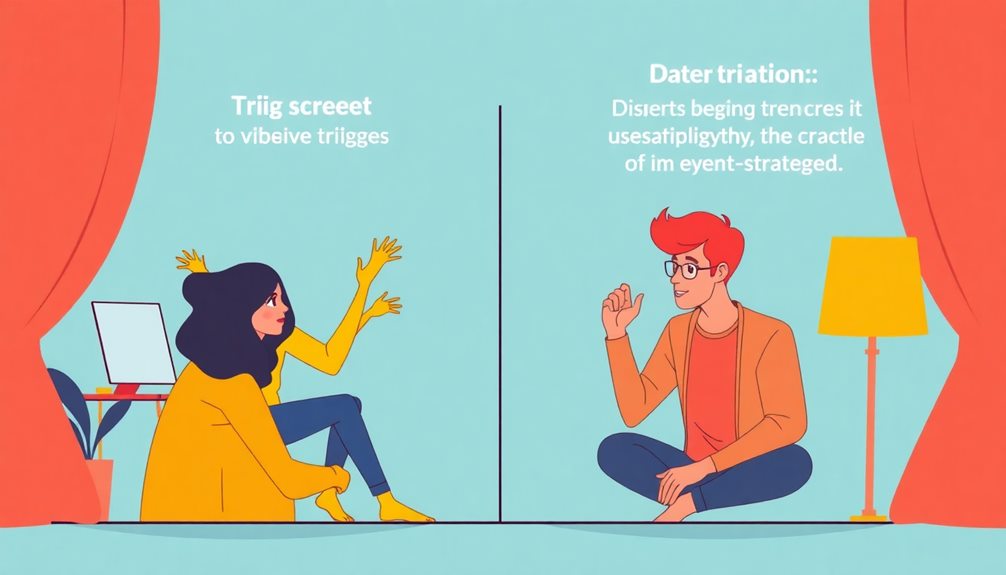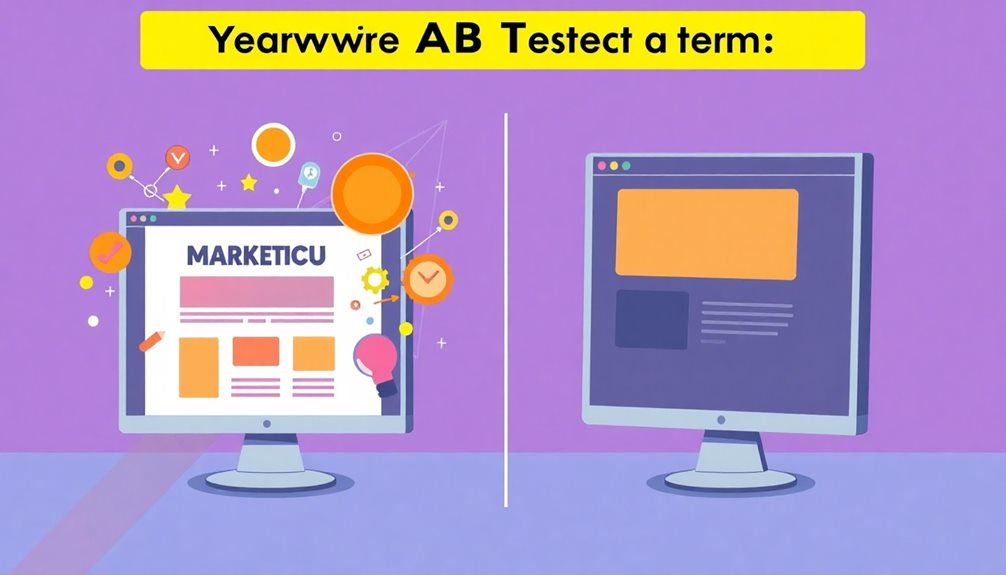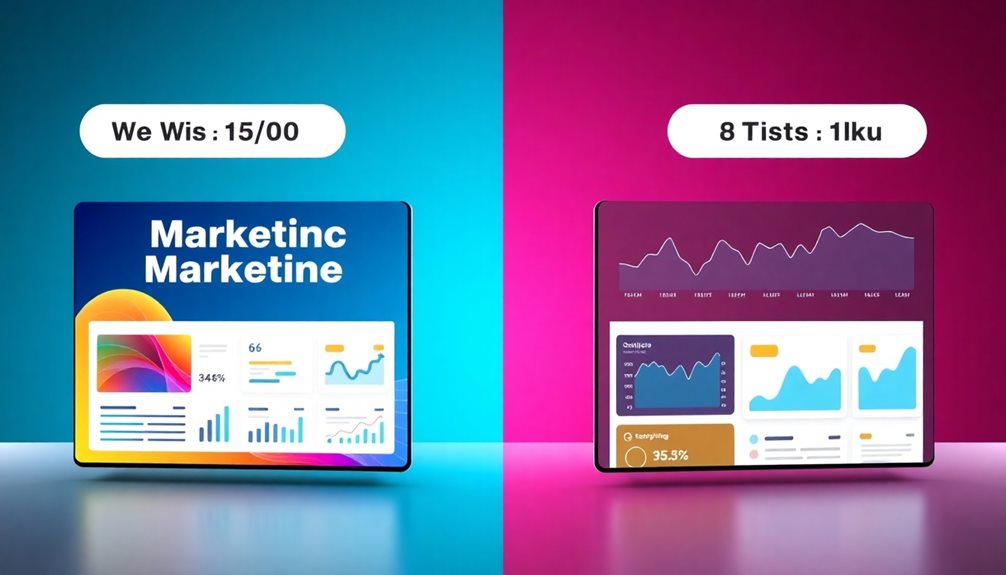A/B testing your way to success with trigger strategies can greatly boost your user engagement and conversion rates. By comparing different versions of your content, you'll identify what resonates best with your audience. When you implement timely and relevant trigger strategies, you not only enhance communication but also see impressive metrics; for example, open rates can soar by over 70%. Focus on key performance indicators to measure your success effectively. You'll improve continuously by analyzing results and refining your approach. There's much more to discover about optimizing your strategies for better outcomes ahead.
Key Takeaways
- A/B testing allows for the evaluation of trigger strategies by measuring their impact on user engagement and conversion rates effectively.
- Implementing behavioral triggers can significantly reduce cart abandonment rates, enhancing overall revenue and user experience.
- Define clear KPIs to measure the success of trigger strategies, ensuring alignment with business objectives for meaningful insights.
- Use data analysis from A/B tests to refine trigger strategies, fostering a culture of continuous improvement and innovation.
- Regularly document and share A/B test results to promote data-driven decision-making and optimize future user interactions.
Understanding A/B Testing Basics

A/B testing is a powerful method that lets you compare different versions of a product or feature to see which one resonates better with users. By randomly assigning users to control and test groups, you guarantee your test results are statistically valid.
This approach allows you to measure user behavior accurately, giving you insights into what works and what doesn't. To enhance user experience and reduce cart abandonment, consider integrating user-friendly navigation as part of your testing variations.
To start, you'll want to establish key performance indicators (KPIs) that will gauge the success of your test. These could include metrics like conversion rates or user engagement levels. It's vital to aim for a minimum of 95% statistical significance in your results, as this indicates that the observed effects are likely not due to random chance.
The A/B testing process is iterative. After analyzing your test results, you can refine your hypotheses and run additional experiments based on the data collected.
This continuous improvement cycle not only enhances your product but also aligns it more closely with user preferences. By understanding A/B testing basics, you're well on your way to making informed decisions that drive better outcomes for your product.
Benefits of Trigger Strategies

Trigger strategies can considerably enhance user engagement by delivering timely and relevant messages tailored to user actions. By leveraging these strategies, you can see significant improvements in your marketing efforts and overall business results.
As evidenced in startup essentials, the emphasis on user feedback can further refine these strategies. Here are some key benefits you can expect:
- Higher conversion rates: Trigger strategies lead to more effective communication, making it easier to convert leads into customers.
- Increased email metrics: You could witness email open rates soar by 70.5% and click-through rates by 152% compared to standard campaigns.
- Reduced cart abandonment: By utilizing behavioral triggers, you can cut cart abandonment rates by up to 15%, reclaiming lost sales.
- Boosted revenue: Personalized reminders for abandoned carts can increase revenue by 10% or more for e-commerce platforms.
Integrating trigger strategies into your A/B testing allows you to assess different approaches and measure results effectively.
You can test a variety of messages and monitor changes in user behavior over time, helping you refine your marketing tactics. With a well-defined test group, you'll gather the insights needed to optimize your strategies for maximum engagement and conversion.
Planning Effective A/B Tests

Planning effective A/B tests involves a strategic approach that aligns your testing objectives with broader business goals. Start by clearly defining your Unique Value Proposition (UVP) to guarantee your A/B testing efforts are relevant and impactful.
Before running an A/B test, establish Key Performance Indicators (KPIs) that are directly tied to your business outcomes. This helps you measure success accurately. Additionally, focusing on high-quality content can increase user engagement and improve overall test outcomes.
Next, formulate specific, measurable hypotheses based on visitor behavior analytics. This will guide your A/B testing strategy and help you focus on high-impact areas.
When you create a new A/B test, remember to utilize segmentation strategies. Tailoring tests for different visitor groups guarantees that your results are applicable and actionable for diverse audience segments.
To maintain the reliability of your results, guarantee that only one variable is altered at a time. This way, you can accurately determine which variant led to any observed changes.
Additionally, make sure to run your tests long enough to reach statistical significance, giving you confidence in your findings. By following these steps, you'll set a solid foundation for successful A/B testing that drives meaningful results.
Key Metrics for Success

To gauge the effectiveness of your A/B tests, it's essential to focus on key metrics that truly reflect user behavior and engagement.
These metrics will help you understand the impact of your changes and guarantee you're on the right track to achieving your business objectives.
Here are some important metrics to take into account:
- Conversion Rate: Measures how many users took the desired action after interacting with your content.
- User Engagement: Evaluates how actively users are interacting with your site, which can indicate the effectiveness of your changes.
- Average Order Value: Tracks the average amount spent per transaction, providing insight into revenue generation.
- Statistical Significance: Establishing a minimum of 95% significance is critical to confirm that your results are reliable and not due to random chance.
Analyzing A/B Test Results

When analyzing A/B test results, it's vital to compare key performance indicators (KPIs) like clickthrough rates (CTR) and conversion rates between your control and variant groups. This comparison helps you determine the effectiveness of your changes.
To guarantee your findings are reliable, aim for a minimum of 95% statistical significance. This threshold confirms that any observed differences aren't just random chance.
Utilize analytics tools to track user behavior and engagement metrics throughout the testing period. This data provides an all-encompassing understanding of how your changes impact users.
After the test, focus on identifying patterns and insights from the collected data. These insights can inform your future testing strategies and enhance your decision-making process.
Don't forget to document and share your results with your team. This practice fosters a culture of experimentation within your organization, emphasizing the importance of learning from empirical evidence.
Continuous Improvement Techniques

Embracing continuous improvement techniques in A/B testing means committing to iterative processes that refine your product features based on real user behavior and feedback. By applying the scientific method, you can systematically enhance your offerings and guarantee they resonate with users.
- Regularly revisit past A/B tests for insights
- Include qualitative feedback through user surveys
- Set clear success metrics and KPIs
- Foster a culture of experimentation
When you gather enough data, you can better analyze the results of an A/B test and make informed decisions. This ongoing process not only helps identify what works but also uncovers areas needing improvement.
Incorporating user feedback can provide deeper insights that quantitative data might overlook. Moreover, setting specific metrics aligned with business objectives guarantees your tests yield meaningful results.
Encouraging your team to embrace experimentation fosters an environment where learning from both successes and failures becomes the norm. This approach leads to greater innovation over time, allowing your organization to adapt and thrive in a dynamic market.
Real-World Case Studies

Real-world case studies showcase the powerful impact of A/B testing in various industries, reinforcing the importance of continuous improvement.
Companies like Booking.com have set the standard, testing over 1,000 variations each year, which led to a 10-15% increase in conversion rates through optimizing user experience.
Similarly, Amazon's split tests on product recommendations have shown that every 1% increase in conversion rate translates to a 1% boost in revenue, highlighting the financial significance of their user interface enhancements.
Google's initiatives have yielded a remarkable 41% increase in click-through rates by exploring different layouts and features, proving that user-driven design can achieve statistical significance.
Facebook, too, refined its ad placements via A/B testing, resulting in a 50% engagement rate increase after optimizing ad visibility based on user behavior.
Netflix benefits from A/B testing as well, using it to enhance content recommendation algorithms, which has led to a 10-12% boost in viewer retention.
These examples illustrate that with careful testing, you can identify winning variants and make informed decisions that elevate user experience and drive your success.
Frequently Asked Questions
What Is the Ab Testing Strategy?
A/B testing strategy lets you compare two variations of a webpage or product feature. You'll measure performance metrics like conversion rates, ensuring you isolate one variable to understand its impact on user behavior effectively.
What Is the Ab Method?
The A/B method lets you compare two versions of a webpage or product. You randomly assign users to either group A or group B, analyzing which version performs better based on user behavior and conversion rates.
What Is an Example of AB Test?
An example of an A/B test is sending two different email subject lines to your audience to see which one gets a higher open rate. You'll discover what resonates best with your subscribers.
What Is the AB Testing Theory?
A/B testing theory juxtaposes experimentation and intuition, letting you test hypotheses about user behavior. By comparing variants and analyzing results, you can uncover insights that drive product effectiveness and improve conversion rates. It's a structured approach.
Conclusion
Just like a gardener tending to their plants, A/B testing with trigger strategies helps you cultivate success in your business. By nurturing different approaches and observing which ones flourish, you'll discover the most vibrant paths to growth. Remember, each test is a seed; some may sprout beautifully while others wither. Embrace this process of trial and error, and soon you'll harvest the fruits of your labor, transforming your efforts into a thriving garden of success.










